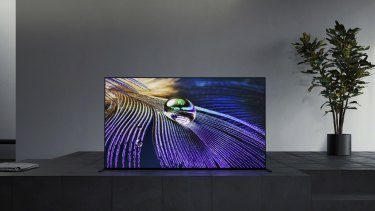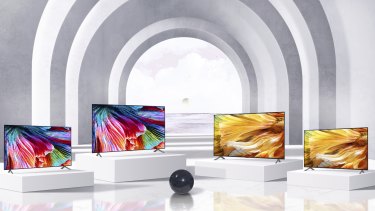
Amid incredible demand for new TVs over the past few months, the biggest names in the business are preparing to introduce new models that look better than ever and offer entirely new tech.
Of course with a spate of amazing televisions comes an overwhelming array of new jargon, acronyms and similar sounding brand names that will confuse TV shoppers everywhere. So what does it all mean, and which ones are actually worth getting excited about?

Sony’s A90J is one of two 2021 sets featuring an OLED panel with LCD-like brightness.
When it comes to picture quality, OLED is king. Unlike LCD televisions, which require a backlight to illuminate the pixels on screen, OLED is self-emissive. This means each and every pixel can be controlled independently and turned off completely, creating infinite contrast.
The problem with OLED has been that it can’t get as bright as LCD, but that changes this year with both LG and Sony releasing re-engineered models that are more efficient, enabling them to hit higher light output levels. A higher peak brightness means you can see more detail in bright HDR scenes, while also making the picture easier to view in a brightly lit living room.
The bad news is that the new brighter OLED panels will be reserved for the more expensive models: LG’s G1 and Sony’s A90J. However LG is also introducing a new budget OLED series in the A1, which nixes gamer friendly HDMI 2.1 ports and features found on the B1 and C1 models, making it a viable option for anyone who just wants the OLED picture quality for watching movies and TV shows.
LCD televisions will also receive a significant boost this year thanks to miniLED display technology — which allows for tens of thousands LEDs in the backlight versus thousands — enabling the panel to deliver better contrast and a higher peak brightness. TCL was the first to market with the X10 making its way to Australia last year, but 2021 will see every major brand except Sony release miniLED TVs. But just to make things confusing, they are all calling it something different. LG is calling its miniLED sets QNED, Samsung Neo-QLED, TCL OD-Zero and Hisense ULED MiniLED.

MiniLED technology, which LG calls QNED, allows LCD TVS to achieve better contrast.
It’s worth remembering that while they all refer to the same underlying display technology, picture quality and pricing will vary depending on the number of LEDs and local dimming zones the manufacturer has deployed in their miniLED televisions. The greater the number of zones, the more control the TV has over how bright or dim parts of the screen can go, but that also drives up the cost.
Most of the companies haven’t yet disclosed pricing or their local dimming zone count, but LG says its 86-inch QNED model will have up to 30,000 LEDs and nearly 2500 dimming zones. This is a big jump when you consider that top-of-the line conventional LCD TVs from last year topped out at a couple of hundred zones.









 Add Category
Add Category